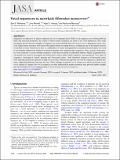Vocal sequences in narwhals (Monodon monoceros)
Date
02/2020Metadata
Show full item recordAbstract
Sequences are indicative of signal complexity in vocal communication. While vocal sequences are well-described in birds and terrestrial mammals, the extent to which marine mammals use them is less well understood. This study documents the first known examples of sequence use in the narwhal (Monodon monoceros), a gregarious Arctic cetacean. Eight female narwhals were fitted with animal-borne recording devices, resulting in one of the largest datasets of narwhal acoustic behaviour to date. A combination of visual and quantitative classification procedures was used to test whether subjectively defined vocalization patterns were organized into sequences. Next, acoustic characteristics were analyzed to assess whether sequences could disclose group or individual identity. Finally, generalized linear models was used to investigate the behavioural context under which sequences were produced. Two types of sequences, consisting of “paired” patterns and “burst pulse series,” were identified. Sequences of burst pulse series were typically produced in periods of high vocal activity, whereas the opposite was true for sequences of paired patterns, suggesting different functions for each. These findings extend the set of odontocetes which are known to use vocal sequences. Inquiry into vocal sequences in other understudied marine mammals may provide further insights into the evolution of vocal communication.
Citation
Walmsley , S , Rendell , L E , Hussey , N & Marcoux , M 2020 , ' Vocal sequences in narwhals ( Monodon monoceros ) ' , Journal of the Acoustical Society of America , vol. 147 , no. 2 , pp. 1078-1091 . https://doi.org/10.1121/10.0000671
Publication
Journal of the Acoustical Society of America
Status
Peer reviewed
ISSN
0001-4966Type
Journal article
Collections
Items in the St Andrews Research Repository are protected by copyright, with all rights reserved, unless otherwise indicated.

